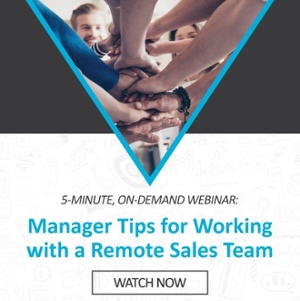
At the core of every successful workforce management practice is communication. As managers and sellers adapt to this new normal, clear communication and scheduled talk time is more important than ever before. Talk time comes in forms such as:
- Manager to seller talk time
- Manager to key customer talk time
- Seller to key and secondary customer talk time
Email is great for communicating data and confirming details, but nothing beats a conversation. Especially when the person on the other end of the line—phone or video—has a problem and needs to tap into your problem-solving expertise. Whether with your sales team, customers, or prospects, regular check-ins promote open communication and stop larger issues from festering, as well as allow for immediate feedback.
 Why Scheduled Talk Time is Important
Why Scheduled Talk Time is Important
People are sequestered, working in new remote environments, and feel isolated. For many in the sales industry, this has reduced the amount of talk time they perform on a day-to-day basis. This void should not be filled by firing off an email that has the tone or purpose of “how can I help” or “just checking in.”
Instead, we should fill this void with strategically scheduled talk time sessions with important customers and sellers. Here are some reasons why:
- Communication is better when we are able to see, hear, discuss, and talk things through with people
- Email volume is up, and many get lost in the email tsunami, and important information is subsequently lost in the inbox
- The informal collaboration and discussion that naturally takes place and helps our ideas to grow and develop could get lost in a world of just emails
- Increasing talk time will make you better because you will learn more about a situation, plus you will demonstrate empathy and problem-solving at a much higher level
- Decision-makers have more time to talk and are willing to make time to talk because they need help due to the current business realities
- Talk time tells the person you care enough to take time out of your busy schedule to lend a helping hand
Make a Connection Through Video
Talk time can, and should, be more than merely talking. Be sure to use the power of technology and involve video whenever possible. It’s easy to use the available technology to make a video connection, and most people are doing it without hesitation.
Traditionally, video screen sharing was reserved for "special occasions" like presentations to customers. Today, savvy managers and sellers are using it for all their calls, and video calls are becoming part of the new normal. “Let’s jump on a Zoom call,” is now a common expression.
In the past, conducting a needs analysis meeting with a customer was considered a face-to-face activity. Many world-class managers and sellers have figured out how to use technology to conduct this uber important talk time activity. Don’t be afraid to try this!
Listen to Your Customers
Last but not least, don’t forget to listen! Here are some tips about listening well to maximize talk time with customers:
- Listen first: the best way to remember to listen is to go into the situation planning to be the one to listen first—of course, you’ll need to talk too but it will be more in response to what the other person has already said
- Seek to understand: demonstrate empathy and listen to understand what is being said from their point.
- Ask questions: the best way to understand something is to as questions
- Don’t interrupt: knowing the best time to interject is an art form
Also, sometimes people just want to talk or just need to vent. We don’t always have to be in uber problem-solving mode. Lending a sympathetic and empathetic ear from time to time is just as valuable and providing a great solution to a complex problem.
Make Scheduled Talk Time a Priority
Filling your schedule with talk time appointments should be a priority. No doubt, alternative forms of communication like email are faster, and at times more efficient; but nothing beats the power of communication when you can see and hear someone.
When scheduling regular check-ins, experts say blocking time off in your schedule, creating discussion points for the check-in, being fully present, problem-solving, and starting with a positive, are some great strategies for effective talk time sessions.

